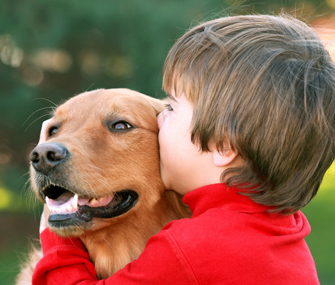News and Notes from The Johnson Center
Pets and Autism
JCCHD | Tue, November 25, 2014 |Pets play a big part in many children’s lives. Anecdotes have been circulating for years about the benefits of having a companion animal in the home of a child who has an Autism Spectrum Disorder (ASD) diagnosis. It is known that animals cause an increase in pro-social behaviors among typically developing children and adults. For example, people are more likely to engage in conversation with a person walking a dog than a person walking alone. Recently, more research has been done that provides evidence that interacting with animals is beneficial for children on the autism spectrum.
Research suggests that children with an ASD who interact with small animals (for example cats, dogs, guinea pigs, and rabbits) have significantly improved social behaviors compared to children with ASD who do not have the opportunity to interact with a small animal. Having a companion animal in the home beginning at age five improves two key social competencies: offering to share with others and offering to comfort someone.

A study published in 2013 showed that children with an ASD had enhanced social behaviors after playing with a guinea pig for ten minutes compared to when they interacted with toys for the same amount of time. These children engaged more often in talking, looked at faces, and made more tactile contact with people when an animal was present. Additionally, children with an ASD received more approaches and interaction from their typically developing peers when an animal was around, which can decrease social isolation.
Animals also increase the frequency of smiling and laughing in children with an ASD. And they can provide a source of unconditional love and support. In addition to increasing pro-social behaviors and being a comfort to children, recent research suggests the presence of an animal can decrease undesirable behaviors like aggression, grabbing, and social isolation.
Families with a child on the spectrum are often willing to try a variety of things to help their child. However, bringing a companion animal into your home is not a decision that should be made lightly. Animals require a lot of time, money, love, and attention, and may not be appropriate if these areas of your life are already stretched. Additionally, an allergy test should be performed on children who will be in the home with the animal to make sure there will not be any allergy issues. It is important to consider if the decision is appropriate for the whole family. It is important that a child shows interest in animals and that they can be trusted to interact with them safely. To determine this, have your child interact with a neighbor or friend’s companion animal first. If the child shows little interest, it may be best for you, the child, and the animal to consider alternatives to animal adoption. If the child is interested and responds positively, it may be something to consider.
References:
Carlisle GK. Pet Dog Ownership Decisions for Parents of Children With Autism Spectrum Disorder.
J Pediatr Nurs. 2014 Mar-Apr;29(2):114-23. doi: 10.1016/j.pedn.2013.09.005. Epub 2013 Oct 16.]]
Grandgeorge M, Tordjman S, Lazartigues A, Lemonnier E, Deleau M, et al. (2012) Does Pet Arrival Trigger Prosocial Behaviors in Individuals with Autism? PLoS ONE 7(8): e41739. doi:10.1371/journal.pone.0041739
O’Haire M. E., Mckenzie S. J., Beck A. M., Slaughter V. (2013). Social behaviors increase in children with autism in the presence of animals compared to toys. PLoS ONE 8:e5701010.1371/journal.pone.0057010
Kaminski, M., Pellino, T., & Wish, J. (2002). Play and pets: The physical and emotional impact of child-life and pet therapy on hospitalized children. Children’s Health Care, 31(4), 321-335.
Johnson, R. A., Odendaal, J. S., & Meadows, R. L. (2002). Animal-assisted interventions research: Issues and answers. Western Journal of Nursing Research, 24(4), 422-440
Solomon, O. (2010). What a dog can do: Children with autism and therapy dogs in social interaction. Journal of the Society for Psychological Anthropology, 38(1), 143-166.
Redefer, L. A., & Goodman, J. F. (1989). Brief report: Pet-facilitated therapy with autistic children. Journal of Autism and Developmental Disorders, 19(3), 461-467.
Martin, F., & Farnum, J. (2002). Animal-assisted therapy for children with pervasive developmental disorders. Western Journal of Nursing Research, 24(6), 657-670.
Wood, L., Giles-Corti, B., & Bulsara, M. (2005). The pet connection: Pets as a conduit for social capital? Social Science & Medicine (1982), 61(6), 1159-1173.



